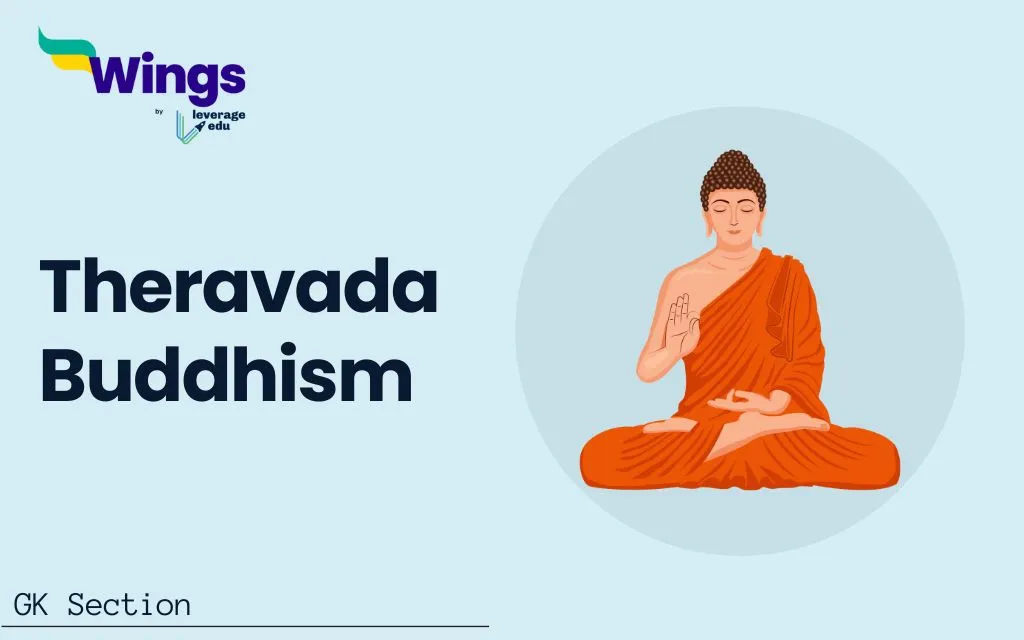Theravada Buddhism is the oldest form of Buddhism and includes the teachings of Siddhartha Gautama. Theravada refers to the ‘School of Elders’, which is also the oldest school in ancient India. Theravada Buddhism is an important tradition within the Buddhist practice. It focuses on Buddha’s teachings, meditation practices, and strong monastic traditions. This is one of the earliest and most important topics of the UPSC‘s art and culture syllabus. In this section, we will discuss Theravada Buddhism and how it has played an important role throughout history. It would also help students understand their history and prepare for civic or competitive exams such as UPSC. Continue reading to learn more.
Contents
Origin of Theravada Buddhism
Theravada Buddhism is one of the oldest forms of Buddhism, dating back to the teachings of Siddhartha Gautama, also known as the Buddha. Siddhartha was born around 563 BCE in Lumbini, modern-day Nepal. After reaching enlightenment at the age of 35, he dedicated the rest of his life to teaching the principles of Dharma.
Theravada, which means ‘teachings of elders’, is the oldest Buddhist scripture. These scriptures were produced during the first Buddhist council and written in Sri Lanka in the first century BCE. The scriptures of Theravada Buddhism have a close relationship to the original teachings of Buddha.
Also Read: Sects of Buddhism: History, Origin, Branches
Practices of Theravada Buddhism
The teachings of Theravada Buddhism stick to the key beliefs and practices. These beliefs or practices are mentioned below:
- Theravada Buddhism obeys the four noble truths, which define the path to freedom. These noble truths include Dukkha, Samudaya, Nirodha, and Magga.
- Dukkha acknowledges the suffering of life, whereas Samudaya views desire and attachment as the primary source of suffering.
- Nirodha suggests freedom from suffering, which is achieved by removing desire and attachment. Magga represents the path to freedom from pain. This path is also called the Noble Eightfold Path.
- This path leads to enlightenment or freedom from suffering. It consists of the right understanding, right intention, right speech, right action, right livelihood, right effort, right mindfulness, and right concentration.
- Theravada Buddhism places a strong focus on meditation to gain insights and achieve enlightenment. These scriptures identify two types of meditation: Vipassana and Samatha.
- Vipassana is an insight meditation technique that involves observing thoughts, feelings, and sensations to better understand their nature.
- Samatha, on the other hand, is a calm meditation that aims to improve attention by focusing on the breath.
- Anatta means non-self. According to Theravada Buddhism, there is no permanent self, but rather a collection of ever-changing physical and mental components.
- All actions have consequences, and the effects of one’s life might continue over into the next birth. The cycle of rebirth continues until one achieves Nirvana or freedom from all desires and suffering.
Community of Theravada Buddhism
The Buddhist community lives in monasteries, and Theravada Buddhism has a rich monastic tradition. They follow a strong community traditions while living together.
- The monks and nuns of this community devote their lives to following the Buddha’s teachings.
- They follow strict ethical and cultural traditions and practice mediation.
- They serve a vital role in the preservation of Buddha’s teachings.
- Lay followers assist the monastic community by donating offerings, which earns them merit.
- Monks seek enlightenment, whereas lay followers improve their future rebirths.
Also Read: Buddhism Philosophy and Concepts
Influence of Theravada Buddhism
Theravada Buddhism is mostly practised in Sri Lanka, Thailand, Myanmar, Laos, and Cambodia. It is still expanding to various parts of the world with the respective teachings.
- It is also expanding across Southeast Asia as a result of immigration and global interest in meditation practices.
- By the 3rd century BCE, Theravada Buddhism had established itself as the primary religion in Sri Lanka.
- Thailand, Myanmar, Laos, and Cambodia also include Theravada Buddhism in their social and cultural heritage.
Contemporary Relevance and Challenges
This ancient religion has had a significant impact on today’s world and its Buddhist practices. It influence on the contemporary era can be seen through various ways.
- Globalization: As Theravada Buddhism spreads to Western countries, it adapts to numerous cultural changes while maintaining its core principles.
- Social Engagement: There is a growing trend within Theravada communities to get involved in social issues such as education, healthcare, and environmental conservation.
- Technological Influence: The social platforms offer a new way to educate and spread the Dharma to a global audience.
Theravada Buddhism continues to inspire millions of followers worldwide. As modern opportunities emerge, Theravada Buddhism remains a meaningful route for people seeking enlightenment and the end of suffering.
Related Posts
| Buddhist Education System | Buddhist Councils: History and Teachings |
| Fourth Buddhist Council: An Overview | How to Prepare History for UPSC? |
| Third Buddhist Council | Mahayana and Hinayana Buddhism |
| How Many Buddhist Councils Were Held? | UPSC Prelims History |
FAQs
Theravada Buddhism is the oldest form of Buddhism, and includes the teachings of Siddhartha Gautama. Theravada refers to the ‘School of Elders’, which is also the oldest school in ancient India. The scriptures of Theravada Buddhism have a close relationship to the original teachings of Buddha.
Theravada Buddhism was founded by Siddharta Gautama, whose teachings are the principles of this religion. Theravada, which means ‘teachings of elders’, is the oldest Buddhist scripture. These scriptures were produced during the first Buddhist council, shortly after the death of Buddha.
Theravada Buddhism is an important tradition within the Buddhist practice. It focuses on Buddha’s teachings, meditation practices, and strong monastic traditions. It continues to inspire millions of followers worldwide.
This was all about the “Theravada Buddhism”. For more such informative blogs, check out our UPSC Exams Section and Study Material Section, or you can learn more about us by visiting our Indian exams page
 One app for all your study abroad needs
One app for all your study abroad needs














